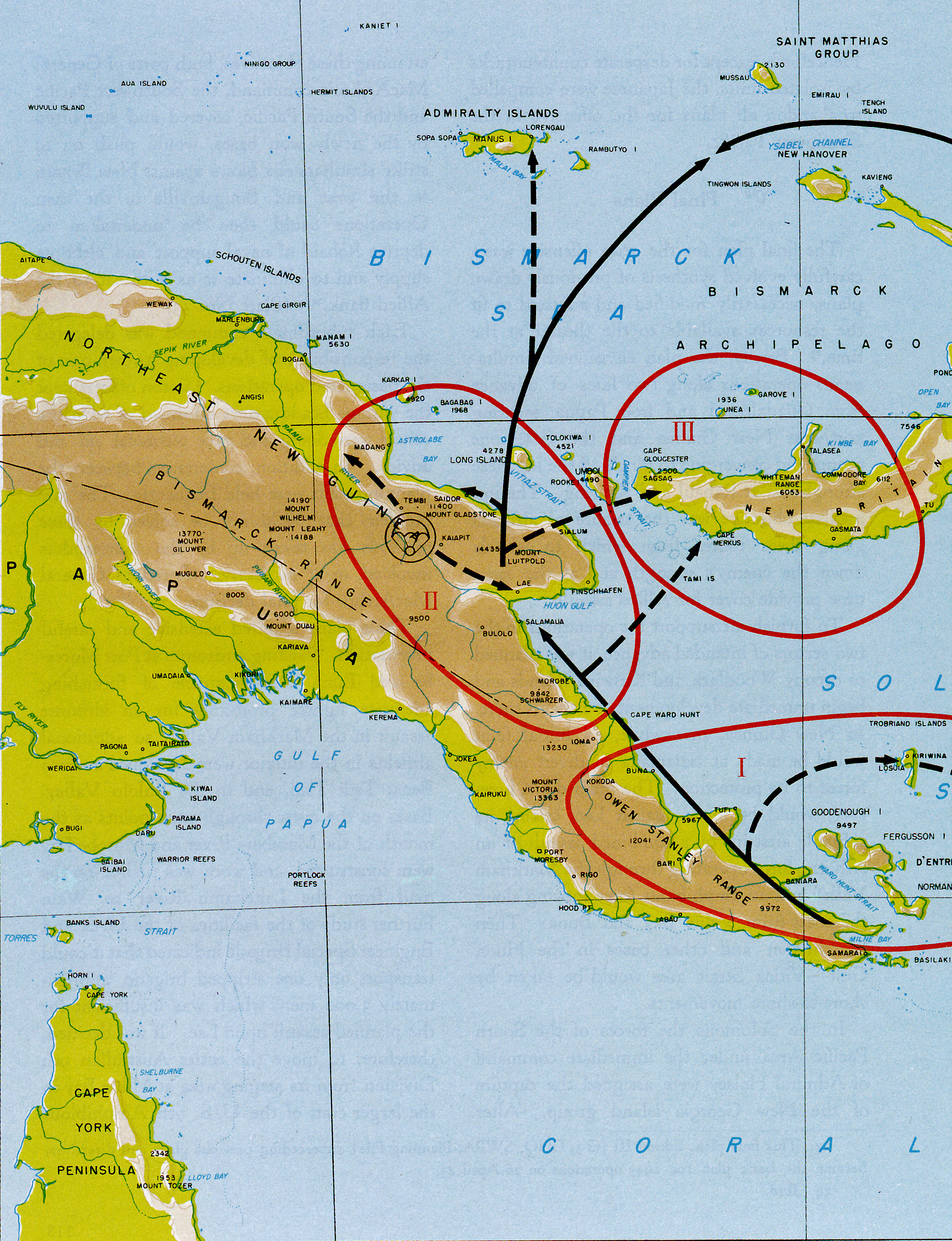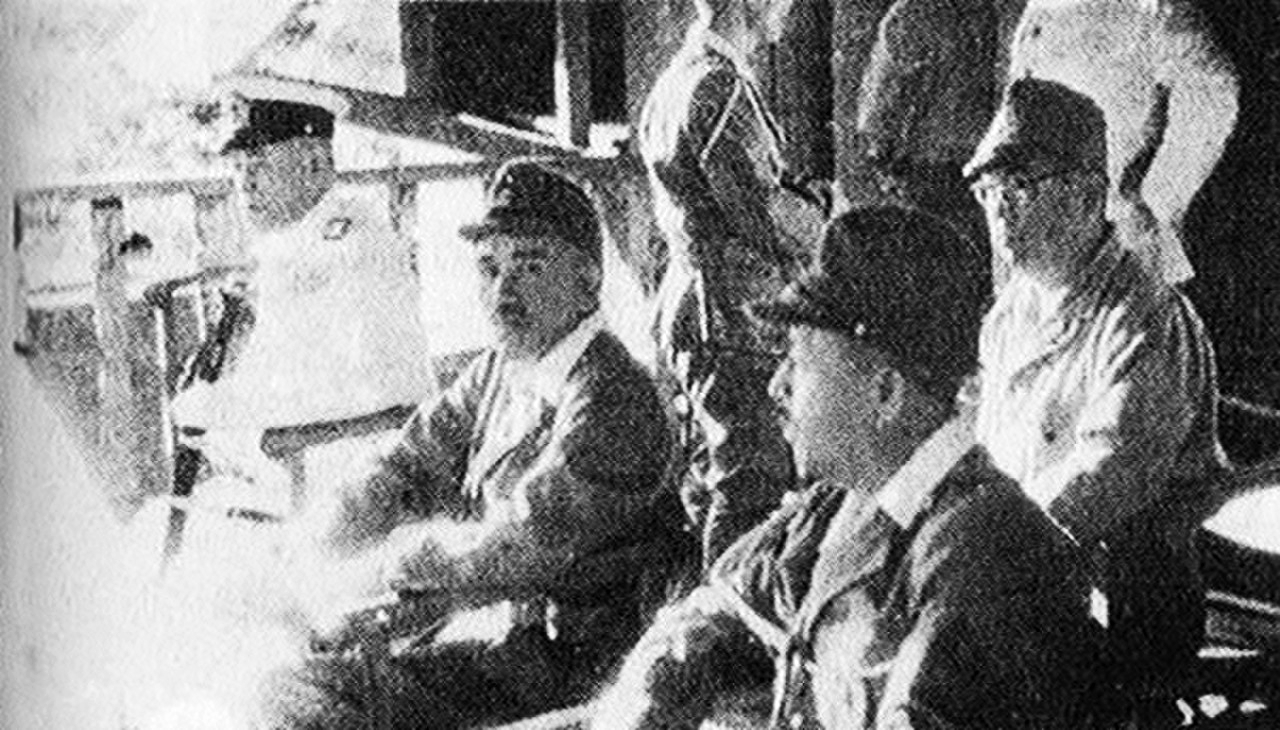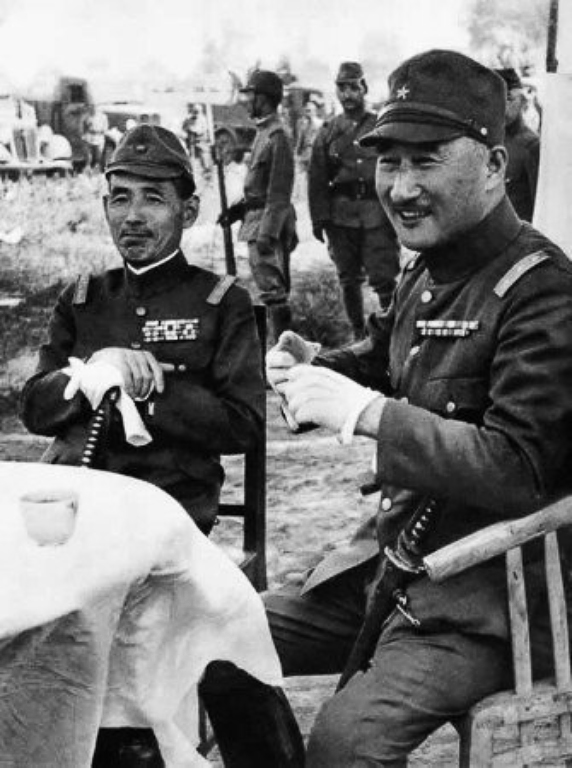|
Operation Cartwheel
Operation Cartwheel (1943 – 1944) was a major military operation undertaken by the Allies in the Pacific theatre of World War II. The ultimate goal of Cartwheel was to neutralize the major Japanese base at Rabaul. The operation was directed by the Supreme Allied Commander in the South West Pacific Area (SWPA), General Douglas MacArthur, whose forces had advanced along the northeast coast of New Guinea and occupied nearby islands. Allied forces from the South Pacific Area, under Admiral William Halsey, advanced through the Solomon Islands toward Bougainville. The Allied forces from Australia, the Netherlands, New Zealand, the United States, and various Pacific Islands took part in the operation. Background Japanese forces had captured Rabaul, on the island of New Britain in the Territory of New Guinea, from Australian forces in February 1942. Rabaul became a major forward base for Japanese forces in the South Pacific, and in turn became the main objective for Al ... [...More Info...] [...Related Items...] OR: [Wikipedia] [Google] [Baidu] |
New Guinea
New Guinea (; Hiri Motu: ''Niu Gini''; , fossilized , also known as Papua or historically ) is the List of islands by area, world's second-largest island, with an area of . Located in Melanesia in the southwestern Pacific Ocean, the island is separated from Mainland Australia, Australia by the wide Torres Strait, though both landmasses lie on the same continental shelf, and were united during episodes of low sea level in the Pleistocene glaciations as the combined landmass of Sahul. Numerous smaller islands are located to the west and east. The island's name was given by Spanish explorer Yñigo Ortiz de Retez during his maritime expedition of 1545 due to the perceived resemblance of the indigenous peoples of the island to those in the Guinea (region), African region of Guinea. The eastern half of the island is the major land mass of the nation of Papua New Guinea. The western half, known as Western New Guinea, forms a part of Indonesia and is organized as the provinces of Pap ... [...More Info...] [...Related Items...] OR: [Wikipedia] [Google] [Baidu] |
United States Third Fleet
The United States Third Fleet is one of the numbered fleets in the United States Navy. Third Fleet's area of responsibility includes approximately fifty million square miles of the eastern and northern Pacific Ocean areas including the Bering Sea, Alaska, the Aleutian Islands, and a sector of the Arctic. Major oil and trade sea lines of communication within this area are critically important to the economic health of the United States and friendly nations throughout the Pacific Rim region. First established in 1943, the Third Fleet conducted extensive operations against Japanese forces in the Central Pacific during World War II. Deactivated in 1945, the fleet remained inactive until 1973, when it was reactivated and assumed its current responsibilities. Mission The Third Fleet plans and executes naval operations in the Pacific Ocean. The fleet provides maritime homeland defense, regional security, and humanitarian operations support through integrated naval and coastguard ... [...More Info...] [...Related Items...] OR: [Wikipedia] [Google] [Baidu] |
Tomoshige Samejima
Vice Admiral Baron , was an admiral in the Imperial Japanese Navy during World War II. Biography Samejima was the grandson of Iwakura Tomomi, and adopted by Admiral Samejima Kazunori a native of Satsuma Domain and noted figure in the Meiji restoration, Tomoshige Samejima graduated 51st of 179 cadets in the 37th class of the Imperial Japanese Navy Academy in 1909. He served his midshipman duty on the cruiser ''Soya'' and battleships ''Sagami'', and ''Katori'' and as a sub-lieutenant on ''Aso'', and ''Hashidate''. After graduating from naval artillery and torpedo classes, he was assigned to the battleships ''Kashima'' and ''Kawachi'' followed by the destroyer ''Kaba''. He was promoted to lieutenant in 1915. He subsequently served on the cruiser ''Azuma'' and battleship ''Kongō'', and after a two-year tour as an instructor at the naval gunnery school from 1918–1920, he was reassigned to the battleship ''Mutsu''. In 1921, he served as aide-de-camp to Prince Higash ... [...More Info...] [...Related Items...] OR: [Wikipedia] [Google] [Baidu] |
Jinichi Kusaka
was an admiral in the Imperial Japanese Navy during World War II. Fellow Admiral Ryūnosuke Kusaka was his cousin. Biography A native of Ishikawa Prefecture, Kusaka graduated from the 37th class of the Imperial Japanese Navy Academy, ranked 21st in a class of 179 cadets. He served as midshipman on the cruisers and , and after being commissioned as ensign was assigned to the cruiser and battleship . As a lieutenant during World War I, he served on the cruiser , followed by the battleship and destroyer , but was not on any combat missions. After the end of the war, he attended the Naval Staff College, emerging in 1921 as a lieutenant commander. He was assigned to the battleship as Vice Chief Gunnery Officer, and to the battleships and as Chief Gunnery Officer. After Kusaka's promotion to captain on 1 December 1930, he was sent overseas to the United States and Europe for one year. After his return, he received his first command, the cruiser . He was subsequently captain ... [...More Info...] [...Related Items...] OR: [Wikipedia] [Google] [Baidu] |
Mineichi Koga
was a Japanese Marshal Admiral and commander-in-chief of the Imperial Japanese Navy's Combined Fleet. Biography Early life and career Koga was born in the ceramics center of Arita in Nishimatsuura County of Saga Prefecture in 1885. He entered the 34th class of the Imperial Japanese Naval Academy and graduated in 1906, ranked 14th of 176 cadets. He served as midshipman on the cruiser on its long-distance navigational training cruise to Honolulu, Hilo, Wellington, Brisbane, Palm Island, Queensland, Batavia, Singapore, Mako, Qingdao, Port Arthur, Dairen, Chemulpo, Chinkai, Busan and Kagoshima. On his return, he was commissioned as ensign and assigned to the , followed by and . As a sub-lieutenant he served on the and , and as lieutenant from 1911, he served on . After further attendance at Japan's Naval War College, Koga held shore staff posting following his graduation and promotion to lieutenant commander in 1917. In 1920, having seen no action duri ... [...More Info...] [...Related Items...] OR: [Wikipedia] [Google] [Baidu] |
Combined Fleet
The was the main sea-going component of the Imperial Japanese Navy. Until 1933, the Combined Fleet was not a permanent organization, but a temporary force formed for the duration of a conflict or major naval maneuvers from various units normally under separate commands in peacetime. History Sino-Japanese War (1894–95) The Combined Fleet was formally created for the first time on 18 July 1894 by the merger of the Standing Fleet and the Western Fleet. The Standing Fleet (also known as the Readiness Fleet) contained the navy's most modern and combat-capable warships. The Western Fleet was a reserve force consisting primarily of obsolete ships deemed unsuitable for front-line combat operations, but still suitable for commerce protection and coastal defense. Vice-admiral Itō Sukeyuki was appointed the first Commander-in-Chief of the Combined Fleet for the duration of the first Sino-Japanese War against China. Russo-Japanese War (1904–05) The Combined Fleet was re-formed ... [...More Info...] [...Related Items...] OR: [Wikipedia] [Google] [Baidu] |
Hisaichi Terauchi
Count was a '' Gensui'' (or field marshal) in the Imperial Japanese Army, commander of the Southern Expeditionary Army Group during World War II. Biography Early military career Terauchi was born in Tokyo Prefecture, and was the eldest son of '' Gensui'' Count Terauchi Masatake, the first Governor-General of Korea and the 9th Prime Minister of Japan. When he was four, his father was transferred to France, and he was sent to live with his maternal aunt in Yamaguchi. Due to his family's close connections with former Chōshū Domain, he was officially registered as a resident of Yamaguchi Prefecture around that time. After his father returned from an overseas assignment, the family moved back to Tokyo. He graduated from the 11th class of the Imperial Japanese Army Academy in 1899, and served as a junior officer in the Russo-Japanese War with the Guards 2nd Infantry Battalion. After the war, Terauchi returned to the Army Staff College and graduated from the 21st class in 19 ... [...More Info...] [...Related Items...] OR: [Wikipedia] [Google] [Baidu] |
William Bostock
Air Vice Marshal William Dowling Bostock, (5 February 1892 – 28 April 1968) was a senior commander in the Royal Australian Air Force (RAAF). During Military history of Australia during World War II, World War II he led RAAF Command, the Air Force's main operational formation, with responsibility for the defence of Australia and air offensives against Empire of Japan, Japanese targets in the South West Pacific theatre of World War II, South West Pacific Area. His achievements in the role earned him the Distinguished Service Order and the American Medal of Freedom (1945), Medal of Freedom. General Douglas MacArthur described him as "one of the world's most successful airmen". A veteran of Military history of Australia during World War I, World War I, Bostock first saw combat as a soldier in the First Australian Imperial Force, Australian Imperial Force at Gallipoli Campaign, Gallipoli, then as a pilot in the Royal Flying Corps on the Western Front (World War I), Western F ... [...More Info...] [...Related Items...] OR: [Wikipedia] [Google] [Baidu] |
George Kenney
George Churchill Kenney (6 August 1889 – 9 August 1977) was a United States Army general during World War II. He is best known as the commander of the Allied Air Forces in the Southwest Pacific Area (SWPA), a position he held between August 1942 and 1945. Kenney enlisted as a flying cadet in the Aviation Section, U.S. Signal Corps in 1917, and served on the Western Front with the 91st Aero Squadron. He was awarded a Silver Star and the Distinguished Service Cross for actions in which he fought off German fighters and shot two down. After hostilities ended he participated in the Occupation of the Rhineland. Returning to the United States, he flew reconnaissance missions along the border between the US and Mexico during the Mexican Revolution. Commissioned into the Regular Army in 1920, he attended the Air Corps Tactical School, and later became an instructor there. He was responsible for the acceptance of Martin NBS-1 bombers built by Curtis, and test flew them. He al ... [...More Info...] [...Related Items...] OR: [Wikipedia] [Google] [Baidu] |
Thomas C
Thomas may refer to: People * List of people with given name Thomas * Thomas (name) * Thomas (surname) * Saint Thomas (other) * Thomas Aquinas (1225–1274) Italian Dominican friar, philosopher, and Doctor of the Church * Thomas the Apostle * Thomas (bishop of the East Angles) (fl. 640s–650s), medieval Bishop of the East Angles * Thomas (Archdeacon of Barnstaple) (fl. 1203), Archdeacon of Barnstaple * Thomas, Count of Perche (1195–1217), Count of Perche * Thomas (bishop of Finland) (1248), first known Bishop of Finland * Thomas, Earl of Mar (1330–1377), 14th-century Earl, Aberdeen, Scotland Geography Places in the United States * Thomas, Idaho * Thomas, Illinois * Thomas, Oklahoma * Thomas, Oregon * Thomas, South Dakota * Thomas, Virginia * Thomas, Washington * Thomas, West Virginia * Thomas County (other) * Thomas Township (other) Elsewhere * Thomas Glacier (Greenland) Arts and entertainment *Thomas (Burton novel), ''Thomas'' (Burton novel) ... [...More Info...] [...Related Items...] OR: [Wikipedia] [Google] [Baidu] |
Arthur S
Arthur is a masculine given name of uncertain etymology. Its popularity derives from it being the name of the legendary hero King Arthur. A common spelling variant used in many Slavic, Romance, and Germanic languages is Artur. In Spanish and Italian it is Arturo. Etymology The earliest attestation of the name Arthur is in the early 9th century Welsh-Latin text ''Historia Brittonum'', where it refers to a circa 5th century Romano-British general who fought against the invading Anglo-Saxons, Saxons, and who later gave rise to the famous King Arthur of medieval legend and literature. A possible earlier mention of the same man is to be found in the epic Welsh poem ''Y Gododdin'' by Aneirin, which some scholars assign to the late 6th century, though this is still a matter of debate and the poem only survives in a late 13th century manuscript entitled the Book of Aneirin. A 9th-century Breton people, Breton landowner named Arthur witnessed several charters collected in the ''Redon_Abbey ... [...More Info...] [...Related Items...] OR: [Wikipedia] [Google] [Baidu] |




